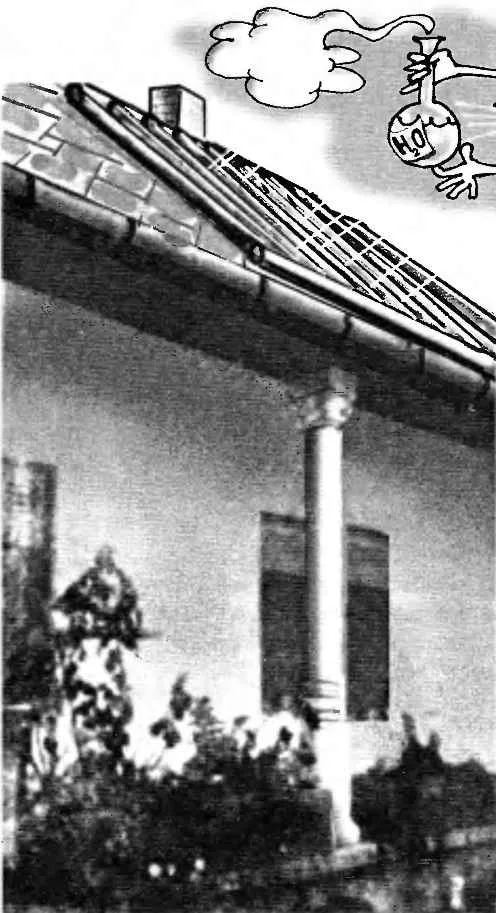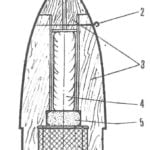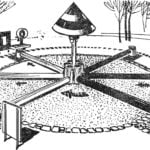Heat exchanger
 The same heat that we feel from sunlight, can be used for household needs in the suburban area — for example, for heating water for shower, dishes or watering plants. A device of this solar heater is simple. Just need the roof set so-called heat exchanger coiled hose connected to the tank with water.
The same heat that we feel from sunlight, can be used for household needs in the suburban area — for example, for heating water for shower, dishes or watering plants. A device of this solar heater is simple. Just need the roof set so-called heat exchanger coiled hose connected to the tank with water.
Immediately it should be noted that for water heating solar heat exchanger is suitable mainly in the spring, summer and early fall (the use of this design in a cold time requires expensive, quite complex, alterations).
The proposed solution is best used for suburban areas not connected to the mains and has a sloping roof (Fig.1). The basis of design — tubular plastic heat exchanger, Packed in a box with dimensions 2×1 m. Its own one-time capacity of approximately 20 liters. Naturally, this is not enough, so you must mount and connect the tank, which will refill the system with water as it is warming up and use.
To place the heat exchanger should be on the South side of the roof so that it does not cover the shadow of nearby  of buildings or trees. The heat exchanger (Fig.2) is connected with located in the attic space of the tank, which must be above the collector.
of buildings or trees. The heat exchanger (Fig.2) is connected with located in the attic space of the tank, which must be above the collector.
The efficiency of the solar heater can be increased if it is placed in the drawer under glazed frame (Fig.2). Even better, if the box is at rest below the roof, inside the attic.
For this you need to remove the roof and the sheathing (from the square, is equal to the size of the heat exchanger), and then glazing the resulting “window”. Apply glass large size rather awkward, and sometimes unsafe, therefore, for this purpose you can use the leaves of medium size. Box of the heat exchanger is attached directly to the rafters of the roof, in such a place that it was provided with direct access to sunlight. In this case it will be better to use thermal solar energy, on the one hand, and excluded from the cooling manifold with the wind.
The extra tank can be used 200-liter barrel, the water which can be pumped one or two times a day with a pump below the water level inside the drum or header does not exceed the nominal value, it is necessary to install the tube for the withdrawal of excess water on the surface of the roof.
An additional tank plays a double role: populates the header as you use it from the hot water and supplies the house with cold water.
Solar heater on the ground
 If the solar heater is arranged only for the summer period — for example, for soul, it can be installed near the booth, erecting it under a simple sloping frame (Fig.3).
If the solar heater is arranged only for the summer period — for example, for soul, it can be installed near the booth, erecting it under a simple sloping frame (Fig.3).
Pipe heat exchanger in this case also fit the spiral or continuous dense snake.
In both cases, the pipe to facilitate can be positioned open, but it is better to put them in a box painted with black paint internal surfaces and glass.
The plane of the heat exchanger relative to the platform on which it is installed must be at a 45° angle and tilted in favor of finding the maximum of the sun. The tank is located above the heater, or directly in the shower.
Heat exchanger-“the fence”
Along with the traditional solution and the location of the collector to provide warm water can be and other decisions. Possible, for example, when each section of pipe pristykovyvayas to two of the transverse connecting segments of larger diameter (see figure.3, 4, 6).
Like as fences, residential houses, villas and gardens, is often used wicker fence from the branches, you can do the fence… plastic pipes solar heater. In this case, the fence posts are made from timber with sawn grooves for the pipes, which, however, do not have, as the pipes can, like in the fence, just weave and lie on top of each other (Fig.4).
The fence may be of any length, since plastic pipe can be cut with a hacksaw or a regular sharp knife and weld or stick together regardless of what managed to get: a coil of pipes or cut in 2 m pieces. Polypropylene at 200°C begins to melt, and then solidified during cooling, so the welding of pipes is simple and accessible to all. Reflow of connected pipe sections, it is sufficient to attach to the end of any red-hot metal plate, and then the edges of the pipes to get to each other. After a few seconds they cooled, forming a strong connection.
“Comb” with traffic
On both sides of each section of the heat exchanger-fence horizontal twisted pipes are connected vertical  the “ridge” of larger diameters (Fig.5). These sections are welded together from individual pipe sections, the joints of which are embedded partition or tube (Fig.6). It is necessary for the normal operation of the heater, which must have a single closed loop passing hot water. And without such partitions pumped into the heat exchanger, the cold water will displace only some portion of already heated
the “ridge” of larger diameters (Fig.5). These sections are welded together from individual pipe sections, the joints of which are embedded partition or tube (Fig.6). It is necessary for the normal operation of the heater, which must have a single closed loop passing hot water. And without such partitions pumped into the heat exchanger, the cold water will displace only some portion of already heated
In pletn’ove the heat exchanger of the continuous serpentine circuit is achieved thanks to the tubes, divide each ridge into sectors. Since the “comb” consists of knee-length, tubes are best installed in places of their adhesions. It is necessary to ensure that the tube does not form the dead, closed areas.
When attaching the horizontal tubes of the heat exchanger to “comb” there is no need to weld: it is enough in each “ridge” weld it under the pipe connection pipes-fitting (see Fig.6), the diameter of which would ensure a close fit of the tube on them. It is not desirable to repeatedly connect and disconnect them: it will ultimately lead to tightness of the connection.
Cold water enters the heat exchanger from the tank through the lower end of one of the “ridges” of warm appears across the top.
It is necessary to ensure that the collector is not subjected to excessive water pressure (it is desirable to have an adjustable water tap in the input water distribution network).
In this embodiment, can also be installed and a water tank for supplying water into the reservoir. Tank better to raise the setting on the welded steel corners of the frame. This decision has its added advantage: the collector will have partially heated water in the tank.
Onoznaczenia:
Fig. 2. The attic location of water heater:
1 —water tank;
2—glazed box heat exchanger;
3 – pipes heat exchanger.
Fig. 3. Shower room (ground) water heater:
1 —frame;
2—pipe distribution of heated water;
3—pipe heat exchanger;
4—pot.
Fig. 4. “Netting”and heat exchanger:
1 — bruski-“stakes”;
2—pipe heat exchanger.
Fig. 5. Heat exchanger- “the fence”:
1 —bruski-“stakes”;
2—pipe heat exchanger;
3—section of the connecting comb.
Fig.6.“The crest of the” heat exchanger:
1 —section of “comb”;
2—drainage pipe;
3—the fittings under the pipe of the heat exchanger;
4—tube-section separator of the comb;
5—water-supply pipe.



